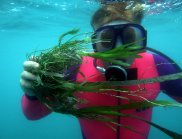Moreton Bay seagrasses make full recovery after the flood
CSIRO marine ecologist, Dr Russ Babcock, will present these and other findings at the Coast to Coast conference being held in Brisbane this week.
Dr Babcock said the seagrasses, which provide habitat to fish and marine organisms and are a major contributor to ecosystem health, had to cope with more than 1 million tonnes of sediment and pollutants contained in flood water runoff.
“Seagrass cover in Moreton Bay declined by half shortly after the floods,” Dr Babcock said.
“Understanding the reasons for these different responses is important if we are to manage and conserve or restore the ecological values of Moreton Bay.”
Dr Russ Babcock, CSIRO marine ecologist
“Seagrasses are affected by the seasons and we expected to see some reduction during winter, but it was great to see them regenerate to pre-flood levels less than 12 months later.”
CSIRO was able to document the effects of the flood on coastal waters as far north as Fraser Island using a range of technologies including remote sensing and robotic underwater gliders that took continuous readings of the flood plume on voyages of over one hundred kilometres.
“It is important to understand how ecosystems such as Moreton Bay respond to extreme events, which can set the scene for ecological trends for many years to come. For example, although seagrasses have recovered from the 2011 flood, there are areas of the Bay where seagrasses have still not recovered from floods in the 1990s.
“Understanding the reasons for these different responses is important if we are to manage and conserve or restore the ecological values of Moreton Bay.”
Coast to Coast 2012 is being held at the Brisbane Convention and Exhibition Centre from September 17-21.
For more information visit www.coast2coastconference.com
Media resources
Click image for high resolution version

